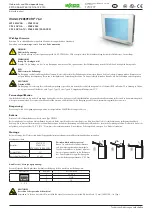
Service Instructions Automatic Single-Head Serging Machine 1265-4
Beisler GmbH
C-19
C.5
Maintenance
C.5.12 Setting the pressures
Fig. 10:
Valve function
1. Pull the valve knob out to unlock the valve, then set
the pressure by rotating the valve.
2. To lock the valve, push the valve knob in.
1
Low pressure foot pressure
2
Manometer
3
High pressure foot pressure
4
Table blowing
5
Transport unit clamping pressure
Pressure foot pressure:
When sewing front trousers with knee lining, the trou-
sers panel can be sewn with the knee lining either on
top or at the bottom.
While the knee lining is sewn, the pressure that the
pressure foot applies to the sewing pieces changes
temporarily and then returns to the normal value. The
two pressures are set seperately using the rotary knobs.
1. If the lining is on top, the pressure applied to the sewing pieces
while sewing the knee lining is reduced. Use the rotary knob
1
to
set the pressure to 0.1 mPa and check the pressure at the manome-
ter
2
.
2. If the lining is at the bottom, the pressure applied to the sewing pie-
ces while sewing the knee lining is increased. Use the rotary knob
1
to set the pressure to 0.25 mPa and check the pressure at the
manometer
2
.
Compressed air nozzles:
To improve the gliding characteristics of the sewing pieces, the working
plate has six compressed-air nozzles near the sewing head. The air
blows from below against the sewing pieces; the resulting air cushion
reduces friction during transport. The pressure depends on the weight
of the material used. It is set using the valve
4
and must be determi-
ned by trial and error.
Transport unit clamping pressure:
The pressure that the transport rollers apply to the working plate is con-
trolled using a pressure reducer. It can be matched to fit the thickness
of the material used.
The pressure is set using the valve
5
and must be determined by trial
and error.
Fig. 10
















































